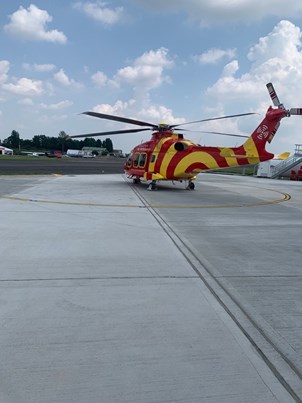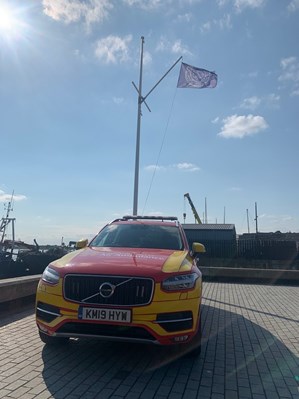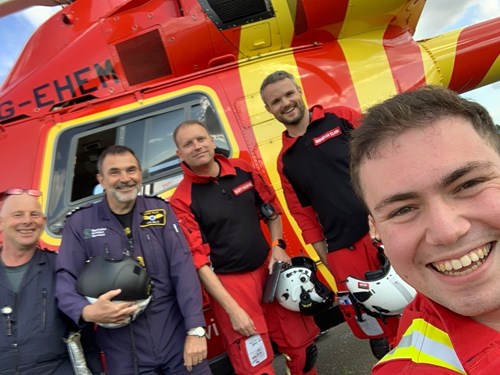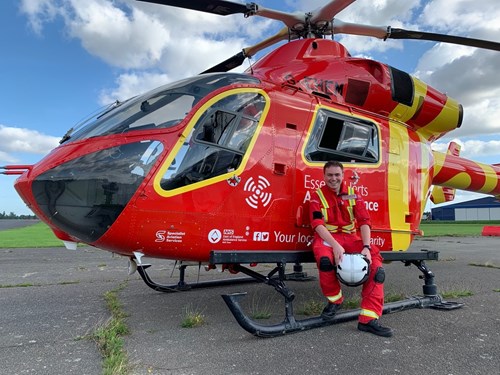
Background
I was honoured to win one of two FPHC elective places to undertake my elective at Essex and Herts Air Ambulance (EHAAT). This organisation serves a population of around 6.2 million people in the East of England, alongside two other Air Ambulance services in the region. EHAAT delivers a pre-hospital emergency medicine (PHEM) team consisting of at least one doctor and one critical care paramedic to the scenes of both medical and traumatic incidents to support ambulance service staff with an enhanced range of medication, equipment, procedures and senior decision-making.
During daylight hours, the trust operates two teams. These teams can deploy either by helicopter or using a rapid response vehicle (RRV) in the event of inclement weather. At night, a single team operating on an RRV serves the same area. Whilst some elements of EHAAT do receive government funding by working in partnership with NHS trusts, the majority of the operating cost is funded by charitable donations from the public, enabling the service to continue to provide a 24-hour critical care service with a strong emphasis on clinical effectiveness and governance.

Aims and Objectives
My aims in my elective were to build on the knowledge of Prehospital Care that I had developed through my intercalated degree with London’s Air Ambulance. I wished to gain an awareness of a different PHEM system, including the differences in structure, governance, culture and clinical case-type. Finally, I wished to develop my clinical knowledge and understanding of the practice of PHEM, integrating myself within the teams I was working with and learning from their years of experience either as paramedics or doctors to improve my clinical assessment and management of critically ill patients.
The nature of the placement
During my attachment, I undertook numerous shifts both during the day and at night. As per the organisational SOP, my role when on prehospital taskings was not active in treating patients, although where appropriate and under the direct supervision of the crew I did assist the crew in instances where an extra pair of hands would come in useful, including in ventilation, defibrillation, IV access, assisting with packaging and moving patients and using knowledge of the kit to find items when needed on scene. However, I was able to put skills and knowledge into practice regularly in a controlled environment due to the organisation’s strong emphasis on simulation as a tool for enhancing learning- one of these “moulage” scenarios is described in detail below as an illustration of the clinical assessment, team-working, decision making and skills I was able to develop during this attachment.
In my six weeks with EHAAT, I undertook 12 clinical shifts, of which around half were at night. During these shifts, I was able to attend 22 HEMS taskings of which 9 were medical and 13 were traumatic incidents. The remainder of my time was spent on base, where I was able to participate in the continuous process of moulage, debriefing, death and disability (D&D) meetings, clinical governance days (CGDs) and case-based discussions which formed part of the crews’ professional development and sign-off processes. I was fortunate that my elective coincided with the induction period for a new cohort of critical care paramedics and flight doctors, so I was able to attend some of their induction lectures enabling me not only to learn about the service at EHAAT, but also about the broader landscape of prehospital care within the East of England region. The fact that there were others just beginning their time with the service was really useful, as I was able to learn alongside them as they got to grips with the vast amount and variety of equipment and medications carried by the service, and familiarised themselves with the governance structures, seminal papers and standard operating procedures that they would need to know from memory in order to complete the rigorous sign-off process.

During my non-clinical time, and when crews were not on base, I was able to immerse myself in the governance side of prehospital care. As my project at EHAAT, I was tasked to write a new Standard Operating Procedure (SOP) for Orbital Compartment Syndrome and Lateral Canthotomy for consideration by the EHAAT Clinical Cabinet. Researching the key considerations for this high-acuity procedure for which most of the literature relates to the Emergency Department, and translating this experience into the prehospital phase allowed me to reflect on just how different Prehospital Care and the Prehospital environment are from the relatively controlled environment that hospital provides.
Clinical Case Moulage- Pedestrian vs Car
Clinical Scenario/Handover:
M-Pedestrian crossing road in town, struck by car going around 40mph. Side-on impact with bullseye on car windscreen.
I- Obvious open Right Tib-Fib, Head injury.
S- Moaning with a noisy airway, no other observations as no ambulance on scene.
T- Police are on scene and bystanders are holding the patient’s head still.
En-Route Discussion
Nearest Trauma Unit: 20 minute drive, 4 minute flight
Nearest Major Trauma Centre: 70 minute drive, 18 minute flight.
Equipment required: 2 Main equipment bags, follow-on bag, blood bag, ventilator bag.
Initial Actions:
CCP tasked to expose patient fully, place on 15L O2 NRB, establish full monitoring and obtain bilateral large bore IV access whilst I performed Primary Survey.
Primary Survey:
<C>- No obvious external haemorrhage
A- Noisy airway with clear obstruction tolerating jaw thrust.
B- No obvious chest injury on inspection and deep palpation. Chest expansion and Air Entry equal. SPO2 86% on 15L. Breathing pattern appears irregular and slow.
C- Thready radial pulse. Central CRT 5 seconds. Abdomen SNT, Pelvis appeared symmetrical. No obvious deformity to long bones. BP 76/40, Pulse 136.
D- GCS E1V2M3. Pupils equal 4mm and sluggishly reactive. Obvious boggy swelling to right side of head with disruption of cranial vault.
E- Obvious open fracture to right lower leg. No other injuries. Appears clammy and sweaty.
Initial Impression and Plan:
After managing the airway with simple adjuncts, I communicated to team that initial impression was that the patient had multiple injuries with the most concerning being the head injury with airway compromise and the potential for unseen chest and abdominal haemorrhage.
The plan was to package the patient in spinal immobilisation and with a pelvic binder, positioning on a scoop stretcher to conduct Prehospital Emergency Anaesthesia (PHEA) to control the airway and provide neuroprotective ventilation. Once this had been achieved, a reassessment of the patient’s haemodynamic status can be considered, including any indication for an emergent transfusion.
Management:
With the CCP supervising, bystanders assisted in the packaging of the patient. I took the opportunity to call the consultant on call to discuss the management plan and the plan for conveying the patient to the MTC. The consultant agreed with the plan and suggested preparing to give blood and tranexamic acid given the mechanism of injury and the need to maintain cerebral perfusion in the presence of a likely traumatic brain injury.
I undertook the PHEA procedure uneventfully, in accordance with the PHEA SOP and secured the airway with an endotracheal tube with the assistance of the CCP. We opted for a low-dose Rapid Sequence Induction using 50mcg of Fentanyl, 70mg of Ketamine and 70 mg of Rocuronium. I then made the decision to give 1 unit of Fresh Frozen Plasma followed by 1 unit of packed blood cells to maintain a systolic BP of 100mmHg. A neuroprotective ventilatory strategy was used.
We simulated packaging for the flight to the MTC and at this point the simulation was ended and I was asked to provide a handover for the team in the Resus Room.
Reflection and Conclusion:
Looking back, it has proven near impossible to sum up the experience of the last 6 weeks in so few words. I have chosen to subdivide my experience into three take-home themes.
The Team and PHEM- Over my time at EHAAT, I was lucky to play a part in extremely highly functioning teams. Whether that be on scene or on base, there was a constant focus on preparation, visualisation and optimisation of equipment and the team ready for whatever the next emergency would be. What was notable was the truly flat hierarchy and the multidisciplinary nature of the teams. Even as a student, attached to the team for a short time, I was able to integrate with the team fully, and my engagement and interest was appreciated and reciprocated by the teams, despite the fact that I was far less experienced and at an entirely different stage of my career. This showed in the way the doctors and CCPs took every opportunity possible to get me involved in their work and offer support and guidance both with regard to PHEM and medicine generally. I was also able to benefit from direct and indirect feedback on my knowledge and skills to help me improve my practice. I recognise how lucky I am to have had this opportunity given that EHAAT is the only organisation which allows medical students this level of engagement with their day-to-day operations.

Governance- The opportunity to be involved so deeply in many aspects of the governance process was truly meaningful. Through D&D, CGDs, participation in induction and sign-off processes for new staff and the opportunity to write a new SOP, I gained an appreciation for the processes which underpin good PHEM practice. The focus is shared between what existing practice is and how it can be refined, improved and driven forward into the future. As a young specialty, with an ever-developing evidence base relating to various aspects of practice, this process of introspection and evaluation is constant within prehospital care, and exposure to these processes at such an early career stage is something that will serve me exceedingly well as I seek to carve out a career in PHEM in the future.
Impact on future practice- By the nature of PHEM, the types of clinical cases I both saw and moulaged were complex and often required technically advanced interventions. However, from a student perspective the lesson that underpinned every instance of patient care was that doing the basic things well will impact more on the patient’s journey than many of the more “advanced” interventions. For every Cardiac Arrest I saw, the basic resuscitation by bystanders was worth as much as the eventual anaesthetic in ensuring survival. Similarly at traumatic incidents, reading the scene, doing a thorough primary survey, identifying injuries and ensuring that the patient was carefully packaged made disproportionate contributions to the eventual outcome, and the opportunity to get so much supervised practice and in-depth teaching on this from true experts is something that has entirely reframed the way I think about Prehospital Care.
Conclusion

My elective has been instrumental in shaping my mental model of the career I wish to find myself in, and one day returning to EHAAT or a similar PHEM service would constitute my dream job. The culture of passionately striving for excellent care for patients, professionalism and inclusive, open governance is one which I believe embodies all that medical practice should be. However, thinking pragmatically that is likely to be nearly a decade from now. In the meantime, as I begin my career as a junior doctor, the overarching message reinforced throughout the elective of “simple things, done well” will figure in my mind constantly as I strive to reach the stage in my professional development where I can even begin thinking about filling the boots of those who have taught me so much on this elective placement. I would like to express my sincere thanks to the Faculty of Prehospital Care at the RCS Edinburgh for allowing me such a phenomenal career-defining opportunity.
Due to essential systems maintenance and upgrades there will be intermittent interruptions to some on-line services on Saturday 27th of February. There will be further interruption to some core services on Wednesday 2nd and Thursday 3rd of March.
We apologise for any inconvenience caused.
×